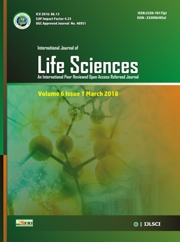Research Article
Volume 8 |Issue 6| November-December 2020 & First published: 16 December 2020
Phytochemical constituents of Terminalia arjuna from Chandrapur district of Maharashtra, India.
Vanashree J Parsodkar1 and Surekha A Kalkar2
1Department of Botany, Govt. Institute of Science, Aurangabad, MS, India
2Department of Botany, Institute of Science, Nagpur, MS, India.
Correspondence Author: Email: janflower4@gmail.com 1 | surekhakalkar@gmail.com2
Abstract
Keywords:Terminalia arjuna, extractive value, Total phenols, Tannins, Flavonoids.
Editor: Dr.Arvind Chavhan
Cite this article as:
Parsodkar Vanashree J and Kalkar Surekha A. Phytochemical constituents of Terminalia arjuna from Chandrapur district of Maharashtra, India, Int. Res. Journal of Science & Engineering, 2020, Volume 8(6): 227-233.
Copyright:
Open Access This article is licensed under a Creative Commons Attribution 4.0 International License, which permits use, sharing, adaptation, distribution and reproduction in any medium or format, as long as you give appropriate credit to the original author(s) and the source, provide a link to the Creative Commons license, and indicate if changes were made. The images or other third party material in this article are included in the article’s Creative Commons license, unless indicated otherwise in a credit line to the material. If material is not included in the article’s Creative Commons license and your intended use is not permitted by statutory regulation or exceeds the permitted use, you will need to obtain permission directly from the copyright holder. To view a copy of this license, visit http://creativecommons.org/ licenses/by/4.0/
References
1. David Phillipson J. Phytochemistry and medicinal plants, Phytochemistry 56 (2001) 237±243.
2. Durairaj Thirumurugan, Alagappan Cholarajan, Suresh S.S. Raja and Ramasamy Vijayakumar, An Introductory Chapter: Secondary Metabolites, 2018; page no. 6.
3. Perspective Plan of Chandrapur District, Maharashtra, (November 2005)
4. Shridhar Dwivedi, Deepti Chopra, Revisiting Terminalia arjuna – An Ancient Cardiovascular Drug, Journal of Traditional and Complementary Medicine, 2014, Vo1. 4, No. 4, pp. 224-231.
5. Muthu C, Ayyanar M, Raja N, Ignacimuthu S. Medicinal plants used by traditional healers in Kancheepuram District of Tamil Nadu, India. J Ethnobilol Ethnomed 2006; 2:43.
6. Stewart, J.L. (1869) Punjab Plants, Government Press, Lahore, as cited by Kirtikar, K.R. and Basu, B.D. (1984) Indian Medicinal Plants, Vol. II, Bishen Singh Mahendra Pal Singh, Dehra Dun, p. 1024.
7. Jain S, Yadav PP, Gill V, Vasudeva N, Singla N. Terminalia arjuna a sacred medicinal plant: Phytochemical and pharmacological profile. Phytochem Rev 2009; 8: 491-502.
8. Yesodharan K, Sujana KA. Ethnomedicinal knowledge among Malamalasar tribe of Parambikulam Wildlife Sanctuary, Kerala. Indian J Tradit Knowledge 2007;6:481-5.
9. Khandelwal K. R. (2002) Practical Pharmacognosy, Technique and Experiments. Nirali Prakashan, Ninth Edition, 23.10-23.11 and 25.1-25.6.
10. Harborne JB. Phytochemical methods A guide to modern techniques of plant analysis, 2008,
11. Buzarbarua Aparna, A textbook of Practical Plant Chemistry, S. Cand & Company Ltd., 2000.
12. Kokate CK, Purohit AP, Gokhale SB, Pharmacognocy , Nirali Publication, 2005.
13. Mudasir Sultana, Pawan Kumar Verma*, Rajinder raina, Shahid Prawez, Dar M A. Quantitative Analysis of Total Phenolic, Flavanoids and Tannin Contents in Acetone and n- Hexane Extracts of Ageratum conyzoides. International Journal of Chem Tech Research, 2012; 4(3):996-999.
14. Naima Saeed, Muhammad R Khan, Maria Shabbir. Antioxdant activity, total Phenolic and Total Flavanoid contents of whole plant extracts Torilis leptophylla L. BMC Complementary and Alternative medicine, 2012; 12:221.
15. Fatma Alhakmani, Sokindra Kumar, Shah Alam Khan. Estimation of total Phenolic content, in- vitro Antioxidant and anti inflammatory activity of Moringa Oleifera. Asian Pacific Journal of Tropical biomedicine. 2013; 3(8):623- 627.
16. Govindappa M, Naga Sravya S, Poojashri MN, Sadananda TS, Chandrappa CP. Antimicrobial, Antioxidant and in virto Anti-inflammatory activity of Ethanol extract and Active Phytochemical screening of Wedelia trilobata (L.) Hitchc. Journal of Pharmacognosy and Phytochemistry. 2011; 3(3):43-51.
17. Boham BA, Kocipai-Abyazan R. Flavonoids and condensed tannins from leaves of Hawaiian Vaccinium vaticulatum and V. calycinium. Pacific Science. 1974; 48: 458-463.
18. Sanjay R. Biradar, Bhagyashri D. Rachetti, Extraction of some secondary metabolites & thin layer chromatography from different parts of Centella asiatica L. (URB), American Journal of Life Sciences 2013; 1(6): 243-247
19. Ayhan Demirbas, Relationships Between Heating Value and Lignin, Moisture, Ash and Extractive Contents of Biomass Fuels, EN ERGY EXPLORATION & EXPLOITATION · Volume 20 · Number 1 · 2002
20. Siddharthan Surveswaran, Yi-Zhong Cai, Harold Corke 1 , Mei Sun, Systematic evaluation of natural phenolic antioxidants from 133 Indian medicinal plants, Food Chemistry 102 2007; 938–953.
21. Mohammad Shahriar, Sadika Akhter, Md. Ismail Hossain, Md. Aminul Haque and Mohiuddin Ahmed Bhuiyan, Evaluation of in vitro antioxidant activity of bark extracts of Terminalia arjuna Mohammad Shahriar, Journal of Medicinal Plants Research Vol. 6(39), 2012, pp. 5286-5298.
22. Pandey AK, Vijayalakshmi Ojha, Swati Yadav and Sonu Kumar Sahu, Phytochemical Evaluation and Radical Scavenging Activity of Bauhinia variegata, Saraca asoka ans Terminalia arjuna Barks. Research Journal of Phytochemistry, 2011, 5(2):89-97.
23. Gunjan M Chaudharia, Raghunath T Mahajanb, Comparative Antioxidant Activity of Twenty Traditional Indian Medicinal Plants and its Correlation with Total Flavonoid and Phenolic Content, Int. J. Pharm. Sci. Rev. Res., 30(1), 2015; Article No. 20, Pages: 105-111.

